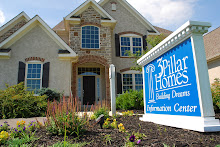It wasn't long ago that the most you could expect for your new house was a white slab of concrete approaching your garage and your front door. Maybe another slab on the other side as a small patio. That was the only option offered by most new home builders.
Thankfully, those days are past. Now the best builders recognize that such "hardscape" areas are essential to the curb appeal of their new homes. What was formerly a neutral -- or detrimental -- feature now delivers distinctive style and a boost to the overall value of the house.
Builders and homebuyers have several options available to vary their hardscape areas and bring a little zing to this neglected element of a home's style. Here are a few to consider:
Stamped concrete. Just as it sounds, the masonry or concrete contractor places textured panels of various sizes over an area of newly poured concrete and applies a slight bit of pressure to make an impression. Once the concrete sets, the panels are removed to reveal a permanent pattern.
Stamped concrete is an excellent and cost-effective way to add the three-dimensional look of a custom-etched or troweled concrete surface, hand-laid bricks or stone pavers. Several patterns, from uniform bricks to more abstract textures, enable builders and homebuyers to satisfy their personal tastes and to compliment the style of the new home. Stamped concrete can be used to highlight the walkway to the front door or create a consistent, dimensional look for all of the home's hardscape areas.
Colored concrete. When colored concrete is desired, a pigment is added as the concrete is being mixed (called an "integral" coloring process). This means that the color is mixed through the depth of the hardscape area, not just painted on the surface. Colored concrete is often used to highlight a hardscape feature, such as a walkway. Used in conjunction with stamped concrete technique, the integral coloring process can enhance the authenticity of a pattern, such as red bricks or dark stone pavers.
Aggregate. Another option that adds dimension to a standard concrete surface is exposed aggregate. Small rounded stones are added to the concrete mix. Then the concrete surface is brushed before the concrete sets, exposing the texture and slight color variations of the authentic pebbles. Exposed aggregate can add interest to an otherwise featureless expanse for a relatively low cost.
Bricks and pavers. There's no substitute for the "real thing" if it fits the budget. Laying individual bricks or stones -- available in various sizes, shapes, and colors -- is a labor-intensive (and thus more costly) endeavor. The preparation for a brick or stone path, patio, or driveway is much the same as that for a poured concrete hardscape. However, laying each brick (and sometimes cutting it to fit), maintaining a pattern and straight lines, and securing the pieces in place with either mortar or sand takes much more time and skill.
One practical advantage of this option: replace individual damaged pieces as necessary. For this reason, we recommend ordering about 5% more material than the job requires so that a consistent appearance can be maintained as pieces are replaced over time. Of course, the greatest advantage to hand-laid bricks and pavers is aesthetic. The natural materials show slight undulations and variations in color and texture that are unmistakable.
Thin (or veneer) bricks and stones can help lower the cost of the hand-laid approach, but these are most suitable as accents, such as lining a concrete driveway or walk. They are less suited to high-traffic areas that must carry greater weight.
Used in creative combinations, the options available for hardscapes offer builders and homeowners unlimited ways to achieve unique surfaces. Effective hardscapes will enhance a new home's architectural style, increase its value and bring long-term satisfaction to the owner.
skip to main |
skip to sidebar
We are a new home builder offering custom home plans to meet your lifestyle and budget. Whether you are in the market for a new, semi custom or custom home, we can help you achieve your dream.
3 Pillar Homes
5710 Delano Ave
Lewis Center, OH 43035
(740) 548-8599




